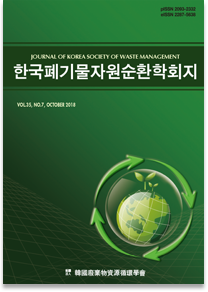이재희 Jae-hee Lee , 최장욱 Jang-wook Choi , 엄태인 Tae-in Ohm
DOI:10.9786/kswm.2025.42.5.246
Abstract
This study quantitatively analyzed the material and energy balance of an energy-self-sufficient waste treatment system by establishing a pilot-scale facility that integrates drying, pelletizing, combustion, and water treatment processes for spent coffee grounds (SCGs). SCGs, with a low recycling rate, were found to be suitable for this system due to their relatively consistent properties, such as ash and volatile matter content, and high calorific value despite high moisture content. The experimental results indicated that pellets made from SCG mixed with 10 wt.% citrus pressed cake had a durability of 98.3 wt.%, satisfying the Grade 1 quality standard for wood pellets. Specifically, 125 kg of pellets were combusted to recover energy for drying 400 kg (62.4 wt.% moisture content) of SCG, yielding 160 kg (6.1 wt.% moisture content) of dry powder (40.0% yield). The total energy consumed, including pellets and electricity, was 594 Mcal, which was 97 Mcal less than the 691 Mcal of energy supplied by dried pellets, confirming the system’s energy self-sufficiency. The heat recovery efficiency of the combustion process was 49.5%, the drying efficiency was 59.2%, and the heat loss was 273 Mcal. The amount of bottom ash generated was very low at 0.7 wt.% of the input material. The water treatment process showed high removal efficiencies of 96.7% for CODMn, 97.5% for TOC, and 99.6% for SS in 240 kg of condensate. These results provide quantitative evidence for the design and scale-up of energy recovery systems for highmoisture organic waste, securing both the energy independence and environmental feasibility of an SCG-based integrated process.
Key Words
Spent coffee grounds, Bio-solid fuel, Energy self-sufficient system, Pelletizing, Material and energy balance










